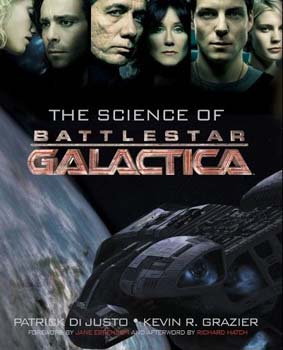Book number two on my iPad completed! This time I went with one through iBooks, Apple’s software/store/whatever for a couple reasons:
- I wanted to compare the experience to the Kindle software.
- The book’s price was the same with either solution.
Like last time, I will get to the technical elements at the end.
As for the content, my mere mentioning of the title usually made most people’s eyes roll which meant you know it’s just a TV show was going through their minds…if it didn’t come out of their mouths. Excellent fiction, especially Sci-Fi, strives for consistency (rules) and works with what’s plausible (what we know about the universe now). The authors receive a few passes to get things rolling (FTL travel being the number one MacGuffin) but if you’re all over the place, the audience will call ‘bullshit’ and lose interest. BSG producer Ron Moore knew this very well from his years with Star Trek: Voyager, probably the worst franchise yet I felt all three Rick Berman shows frequently had sloppy, lazy Matlock in Space episodes to pad their seasons. Better yet, try watching the original BSG from the late Seventies now. Besides being Mormons in Space, the writers’ ignorance of basic Astronomy is painful.
I decided to get this book because it’s co-written by Dr. Kevin Grazier who was the show’s Science advisor. Grazier’s regular day job is working at JPL with the Cassini/Huygens probes observing Saturn and its moons. He also teaches Astronomy, planetary Science and Cosmology so I wish I had the means to take his courses. Lastly, he is friends with Dr. Phil Plait which automatically raises his stock with me. Patrick Di Justo is the more professional writer yet has a strong scientific background by building experiments for STS-107 (sadly, the last mission for Columbia). As for BSG, I’m of two minds about it. Eventually I will write about it since this book did motivate me to start re-watching from the beginning after Netflix posted the two-part pilot, which I hated for reasons I’ll state another day. Before any tells me…yes, I know how it ended and this is why I stopped with five shows remaining. I blame the ’07 Writers’ Strike for the crappy conclusion.
Did I like BSG? Compared to other Sci-Fi programs? Yes. I won’t go on with an elaborate explanation beyond I enjoyed it enough to read about the Science which was the most accurate I’ve seen after Babylon 5. Plus Dr. Grazier and another producer went through all the trouble to make this map I scored earlier. If they went through this much trouble to explain how the Colonials came from 12 inhabitable planets in such close proximity, I had to know about the rest.
Science is broken down into four key sections:
- Life Here Began Out There. This would be the Biological matters like how easily amino acids are created on other worlds, Colonial physiology (they’re not 100 percent Human) and why didn’t the Cylons show up in standard medical examinations. The latter resulted in a minor argument with a friend. I was very convinced by the authors.
- The Physics of Battlestar Galactica. How important energy, gravity and time dilation are with interstellar travel. The sections covering nuclear weapons provided no comfort. Artificial gravity was a bummer; in short, it can’t be done short of magic due to the force’s spherical nature. Rotating sections as per 2001, 2010 and B5 don’t work reliably; passengers barf from space sickness if it’s too slow or motion sickness if it’s too fast.
- The Twelve Colonies and The Rest of Space. The Astronomy portion was somewhat a repeat on what I’ve read from Dr. Plait’s books.
- Battlestar Tech. Emphasis on weapons, namely why the writers chose contemporary stuff (bullets) and kinetic-energy (KEWs) over traditional Sci-Fi conventions (lasers, fusion, plasma, etc.). I never did get a decent explanation on how the Jump Drive worked beyond what is the definition of the red line for Colonial vessels (approximately five light years). Interstellar navigation is possible by checking the positions of neighboring galaxies unlike Star Trek‘s central navigation beacon or common stars. I need to bug my old Traveller GM Flynn about this when I was the navigator of an ill-fated mission; I tried to make the argument for spectral analysis. Now I know better!
The writing is excellent. Di Justo and Grazier convey the technical information without dumbing it down dramatically nor buffalo it in super jargon for grad students. There are some formulas I will need help understanding if I ever want to run a good d20 Future campaign; life before affordable spreadsheet software was a pain. Science would be a great gift to give a pre-teen (or older) person with a modest interest in Physics and/or Astronomy. I did buy a Kindle copy to give my sensei Lester for his birthday, I need to get his two cents! Being at least a casual fan of the show helps but it isn’t a requirement. I was impressed with the authors’ name-dropping for comparisons: Star Trek, Star Wars, B5, Dune, Firefly (craptacular) and 2001 (the most realistic movie ever made).
However, I can’t recommend Science beyond its built-in audience. It’s a great primer but Americans generally have little interest in academic subjects due to the nation’s crappy priorities. Count on the first permanent Moon base to be Chinese or Indian.
Part Two: How was it on the iBooks software via the iPad?
Not much better than Kindle. They’re pretty identical in their abilities resize the type, page turning, altering the brightness and activating a sepia-based background (easier on some people’s eyes versus white, Kindle can do black for those bordering on blindness). iBooks’ only advantages were bookmarking and navigating. It shares Kindle’s annoying issue with layouts which was more pronounced in Science through captions; they’re frequently found on the preceding or following pages containing the photo.
Which do I recommend now that I’ve completed one of each? For me, price won right after selection (Kindle is winning here yet iBooks is closing the gap). If it costs the same (as it was with Science), then iBooks has the advantage and I’d get the iPad edition.
Sadly, electronic versions of books aren’t proving to be any cheaper than hard copies in the short run. So much for parity with music. Maybe this will change with Amazon’s recent announcement regarding their electronic sales exceeding physical copies.

